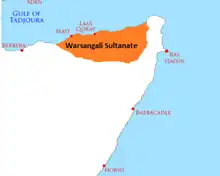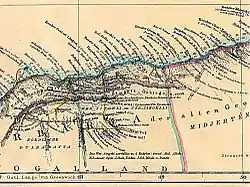Warsangali Sultanate
The Warsangali Sultanate (Somali: Saldanadda Warsangeli, lit. 'Boqortooyada Warsangali', Arabic: سلطنة الورسنجلي), was a Somali imperial ruling house centered in northeastern and in some parts of southeastern Somalia.[1] In 1884, the United Kingdom established the protectorate of British Somaliland through various treaties with the northern Somali sultanates (Dir, Isaaq and Harti including the Warsangali). The Warsangali clan constituted 20,000 of British Somaliland's total population of 640,000 (3.1%).[2]

Warsangali Sultanate Saldanadda Warsangeli سلطنة الورسنجلي | |||||||
|---|---|---|---|---|---|---|---|
| Possibly late 12th-early 17th century–1887 | |||||||
 Map of the Warsangali Sultanate circa, 1857 | |||||||
| Capital | Las Khorey | ||||||
| Common languages | Somali | ||||||
| Religion | Islam | ||||||
| Government | Monarchy | ||||||
| Sultan | |||||||
| History | |||||||
• Established | Possibly late 12th-early 17th century | ||||||
• Disestablished | 1887 | ||||||
| Area | |||||||
• Total | 54,231 km2 (20,939 sq mi) | ||||||
| |||||||
| Today part of | Somalia | ||||||
History
Background
The Warsangali Sultanate, also known as the Garaad Dynasty, was a Somali imperial governing dynasty headquartered in northeastern and southeastern Somalia. It was one of the biggest sultanates ever founded in the province, including the Sanaag region and sections of the country's northeastern Bari region, which was traditionally known as Maakhir or the Maakhir Coast. The Sultanate of Gerad Dhidhin was established in northern Somalia in the late 13th century by a group of Somalis from the Warsangali branch of the Darod tribe and was controlled by the descendants of the Gerad Dhidhin. The Sultanate was controlled by the powerful Sultan Mohamoud Ali Shire in the late nineteenth century, during some of its most violent years. The Akil Dhahar dominated the area south of Sanaag and parts of the Bari region.[3]
The Sultanate is recognized for its remarkable longevity as a political entity and its tendency to prioritize trade over conquest or expansionism. The Sultanates major ports included Maydh, Bosaso and finally Laasgoray, its capital.[4]
British-Warsangali Treaties
Under threat of violence from the British Empire, several northern Somali sultanates, including the Warsangali Sultanate, signed numerous treaties that led to the establishment of the British Somaliland protectorate in 1887.[3]
Warsangali treaty with the British government:[5][6]
TREATIES, &c., between the Warsangalis (British Protection; Slave Trade; Wrecks: &c.). – January 27, 1886
The British Government and the Elders of the Warsangali tribe who have signed this Agreement being desirous of maintaining and strengthening the relations of peace and friendship existing between them;
The British Government have named and appointed Major Frederick Mercer Hunter, C.S.I., Political Agent and Consul for the Somali Coast, to conclude a Treaty for this purpose. The said Major F. M. Hunter, C.S.I., Political Agent and Consul for the Somali Coast, and the said Elders of the Warsangali, have agreed upon and concluded the following articles:-
ART.
I. The British government, in compliance with the wish of the undersigned Elders of the Warsangali, undertakes to extend to them and to the territories under their authorities and jurisdiction the gracious favour and protection of Her Majesty the Queen-Empress.
II. The said Elders of the Warsangali agree and promise to refrain from entering into any correspondence, Agreement, or Treaty with any foreign nation or Power, except with the knowledge and sanction of Her Majesty's Government.
III. The Warsnagali are bound to render assistance to any vessel, whether British or belonging to any other nation, that may be wrecked on the shores under their jurisdiction and control , and to protect the crew, passengers, and cargo of such vessels, giving speedy intimation to the Resident at Aden of the circumstances; for which act of friendship and good-will a suitable reward will be given by the British Government.
IV. The Traffic in slaves throughout the territories of the Warsangali shall cease for ever, and the Commander of any of Her Majesty's vessels, or any other British officer duly authorized, shall have the power of requiring the surrender of any slave, and of supporting the demand by force of arms by land and sea.
V. The British Government shall have the power to appoint an Agent or Agents to reside in the territories of the Warsangali, and every such Agent shall be treated with respect and consideration, and be entitled to have for this protection such guard as the British Government deem sufficient.
VI. The Warsangali hereby engage to assist all British officers in the execution of such duties as may be assigned to them, and further to act upon their advice in matters relating to the administration of justice, the development of the resources of the country, the interests of commerce, or in any other matter in relation to peace, order, and good government, and the general progress of civilization.
VII. This Treaty to come into operation from the 27th day of January, 1886, on which date it was signed at
Bunder Gori by the Undermentioned.
F. M. Hunter
Witness:
J. H. Raintier, Commander, R. N.
Muhammad Mahmud Ali, Gerad of all the Warsangali.
Jama Mahmud (reer garaad), Muhammad Ibrahim(reer garaad), Omar Ahmed(reer garaad), Mahmud Abdullah(reer garaad),Yusuf Mahmud(reer garaad). Nur Abdullah(reer fatah), Isa Adan(reer fatah), Muhammad Ali Shirwa(reer fatah), Abdy Nur(reer fatah).Muhammad Abdi Nalaya(ogeyslabe), Mahmud Sagully(ogeyslabe), Abdullah Sagully(ogeyslabe), Muhammad Abdulah(ogeyslabe).
Northern Somali sultanates
In his paper The 'Mad Mullah' and Northern Somalia, the historian Robert L. Hess touches upon this alliance, writing that "in attempt to break out of Obbian-Mijertein encirclement, the Mullah sought closer alliances with the Warsangali of British Somaliland and Bah Geri of Ethiopia".[7]
Sultans

Rulers of the Warsangali Sultanate:[8][9]

Warsangali-Dervish collaboration
In May 1916 the Dervish attacked Las Khorey but were repelled by a British Warship. In September of that year fearing a Dervish invasion, British troops occupied Las Khorey at the insistence of Sultan Mahamud ALi Shire.[10]
| # | Sultan | Reign | Notes |
|---|---|---|---|
| 1 | Garaad Dhiidhin | 1298–1311 | In the late 13th century, he established the Warsangali Sultanate. |
| 2 | Garaad Ibrahim Hamar Gale | 1311–1328 | Gerad Dhiidhin ibrahim Hamar Gale's son established his rule in southern Somalia's Lower Juba Kismayo, which is known as Juba-land. |
| 3 | Garaad Hassan Ibrahim Hamar Gale | 1328–1340 | Son of Gerad Hassan Hamar Gale |
| 4 | Osman Ibrahim | 1340–1355 | After the death of his father, Gerad Ibrahim H Hamar Gale, the eldest son of Osman Ibrahim Riighaye, ascended to the kingdom. The first ever made in the Maakhir Coast's Warsangali Kingdom. |
| 5 | Muse Ahmed | 1355–1372 | Riighaye's eldest son ascended to the throne. |
| 6 | Cigale Ahmed | 1372–1386 | Gerad Muse Ahmed's son |
| 7 | Ali Cigale Ahmed | 1386–1407 | |
| 8 | Muse Ahmed | 1406–1420 | |
| 9 | Muse Ahmed | 1420–1437 | |
| 10 | Nuur Ali Cigale | 1437–1458 | |
| 11 | Mohamed Ali Cigale | 1355–1372 | The Sultanate's most difficult years began. |
There is constantly a power struggle between the Brothers battling each other to succeed in the rulership, which contributed to a decrease in the sultanate's governability over its realm between the 13th and 17th centuries.
| # | Sultan | Reign | Notes |
|---|---|---|---|
| 1 | Garaad Mohamud IV | 1655–1675 | |
| 2 | Garaad Naleye | 1675–1705 | |
| 3 | Garaad Mohamed | 1705–1750 | |
| 4 | Garaad Ali | 1750–1789 | |
| 5 | Garaad Mohamud Ali | 1789–1830 | |
| 6 | Garaad Aul | 1830–1870 | |
| 7 | Garaad Ali Shire | 1870–18 | |
| 8 | Sultan Mohamoud Ali Shire | 18–1887 | Last Sultan of the Warsangali Sultanate |
See also
- Adal Sultanate
- Ajuran Sultanate
- Mohamoud Ali Shire
- Mohammed Abdullah Hassan – religious and nationalist leader
- Yusuf Ali Kenadid – founder of the Sultanate of Hobyo
- Somali aristocratic and court titles
- List of Muslim empires and dynasties
- List of Sunni Muslim dynasties
- Sultanate of Hobyo
- Majeerteen Sultanate
Bibliography
- Lewis. I. M. A Modern History of Somalia: Nation and State in Horn of Africa. Ohio: Ohio University Press, 1960.
- Speke. John Hanning. "Sultan/Garaad Mohamoud Ali—Hidden Treasure—Royal Reception—Sultan Tries my Abban". What Led to the Discovery of the Source of the Nile. Edinburgh: Edinburgh William Blackwood and Sons 1864.
- Alinur, Said. "Abyssinian Invasion: Reminder of a Seven Century old Animosity". 17 January 2007. Source
References
- Abdullahi, Abdurahman (2017). Making Sense of Somali History: Volume 1. London, United Kingdom: Adonis & Abbey publishers ltd. p. 63. ISBN 978-1909112797.
- Lewis, I. M. (1999). A Pastoral Democracy: A Study of Pastoralism and Politics Among the Northern Somali of the Horn of Africa. James Currey Publishers. ISBN 9780852552803.
- Surhonee, L.M.; Timpledon, M.T.; Marseken, S.F. (2010-07-03). Warsangali Sultanate. VDM Publishing. ISBN 978-6130586324.
- Briggs, Philip (2012). Somaliland : with Addis Ababa & Eastern Ethiopia. Internet Archive. Chalfont St. Peter, Bucks, England : Bradt Travel Guides ; Guilford, CT : Globe Pequot Press. pp. 10–12. ISBN 978-1-84162-371-9.
- "Heshiiskii 27kii January, 1886". allsanaag. allsanaag. Retrieved 2023-04-15.
- "Agreement between Great Britain and the Warsangali (Somali Coast), signed at Bunder Gori, 27 January 1886". Oxford Public International Law. Oxford Historical Treaties. 1886-01-27. Retrieved 2023-04-15.
- Hess, Robert L. "The 'Mad Mullah' and Northern Somalia" (PDF). Journal of African History. 1964: 423. Retrieved 10 February 2018.
- "Sultan of Warsangali, Somalia". The African Royal Families. Retrieved 2 June 2022.
- ""Rulers of the Warsangali Sultanate"" (PDF). Ferroon11. Retrieved 27 April 2014.
- "King's College London, King's collection : Ismay's summary as Intelligence Officer (1916–1918) of Mohammed Abdullah Hassan".
